View current page
...more recent posts
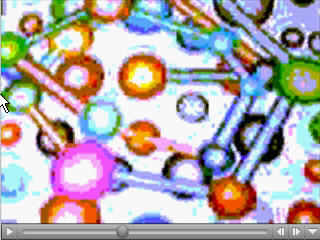
Above is a screen shot for an animated .GIF of mine that I saved as a 3.32 MB Quicktime movie. It depicts the growth of endorphins in a test subject watching Wheel of Fortune with his relatives at Thanksgiving (not really, I just put that in as a grant-friendly soundbite). Click here to view. One orange sphere is an "anomaly."
War and politics talk has been muted on this page since the shock of learning the exact number of torture-toleratin' Jesucrats out there (59 million, wasn't it?). Comments continue to trickle in along the lines of, "now let's not offend the Bushvoters." Of course I'd like those folks to admit their bloodthirsty instincts prevailed over what was best for America in the larger world, but my strongest bond is with people who marched against the war or had a sick feeling in the pit of their stomach when they saw the Abu Ghraib photos, as opposed to racist glee, numbness, or the naive belief that it was the work of "a few bad eggs." True, Kerry never mentioned the pictures in the campaign, but he at least had a conscience about US military excesses at one time in his life. Conventional wisdom had it that if he'd come off as a peacenik he would have lost even bigger. Now we're back to the Vietnam days of destroying villages to save them and glorifying Marlboro men for military exploits that mean...what, precisely? Oh, yeah, quelling local rebellions of Muslim extremists so that democracy can be spread to the rest of Iraq.
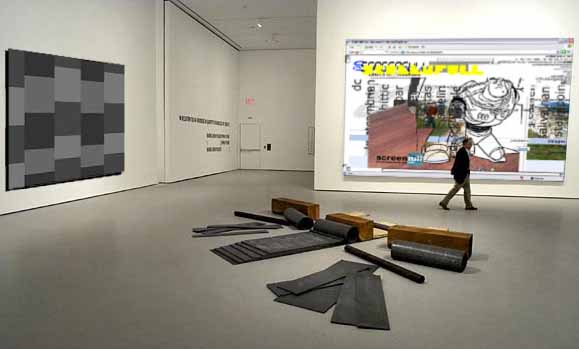
Haven't been to the rehung MOMA yet. On principal, this page worships Alfred Barr and believes his successors are "grocery clerks," to use Colonel Kurtz's phrase. Once it became apparent the museum would never be the dynamic collection Barr originally envisioned, shedding older works as it acquired newer ones, it should have left well enough alone and enshrined his gripping narrative as whole generations saw and remember it. Anyone not as smart and perceptive as he perhaps ought not presume to tamper with what worked--as in, sold the world on a particular (ostensibly too linear, politically unbalanced) vision of artistic change at a particular moment in history. Whatever one thinks of Cezanne's position as the cornerstone of pictorial Modernism, the current staffers' substitution of that corny Paul Signac in his place at the entrance is just lame. Dress the decision up as they will, as signifying the importance of proto-Pop or what have you, it was evidently a flattering-the-donors move, as the Signac is pledged to the museum by David Rockefeller. Above, left to right: Christopher Ashley, Robert Morris Serra, Abe Linkoln. Picture courtesy Screenfull & Look, See.
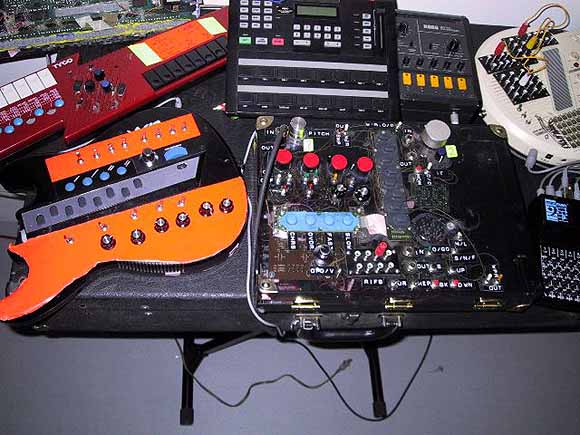
As an example of the circuit bent gear phenomenon mentioned in the previous post--this is Nautical Almanac's equipment table.
Paul Slocum is doing some interesting work in the emerging "circuit bent" field, where old games, toys, and keyboards get broken open and rewired to make new sounds. Check out his repurposed Epson dot matrix printer that makes music and still prints out images. This is fascinating on the level of Mad Maxian, Professor-making-a-nuclear-reactor-out-of-the-ship's-radio-and-coconuts bricolage (or as an illustration of the Gibsonian axiom "the street finds its own uses for things"), but the printer is only part of a larger gesamtkunstwerk, including Slocum's band Tree Wave (a duo with Lauren Gray), which is making some of the coolest music around. While the band uses the printer and other low-tech gear (1977 Atari 2600 game console, 1986 portable 286 PC, 1983 Commodore 64 computer) to make its music, it's not the annoying, tuneless gameboy stuff we've been hearing in the galleries lately but rather has been compared to guitar bands such as My Bloody Valentine and early Stereolab. This is because the computers use fuzz tones and other psychedelic guitar-like sounds as opposed to pure video game bleeps. "Sleep" is a simply amazing 3 minutes of music that updates the Krautrock formula of drones-over-insistent-beats with rich, jangly, unmistakably consumer-electronic textures that just seem to keep surfacing in the mix. Catchy, crunchy rhythms kick away underneath while spare but sublime femme vocals float in over the top. The equipment runs with custom music software written by Slocum for the band, obviously with a very analog-sounding end product in mind. According to the website there is also a video element used in live performance. Hopefully we'll get to see and hear all this here in NY soon.
UPDATE: Slocum's thoughts on whether his work is really circuit bending here.
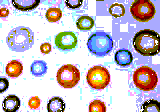
The Creepy Clown website has been mentioned here a few times (originally in this post) as an example of a populist, database-oriented art project that actually has some life to it. In all honesty, much of it is crap. For those who don't know, Creepy is a downloadable stock character made in a 3-D rendering program such as Bryce or Poser and plugged into a variety of situations and settings. The site formerly had a front page displaying some of the best Creepys, but now it's all grouped by artist and you have to slog through many inane pictures of Creepy making bunny ears behind George Bush's head to find what I consider the "classic Creepys." Fortunately I saved many of them from the original front page and offer them here as a public service. The ingredients of a classic Creepy are: (i) technically amazing rendering skills bumping up against the inherent "uncanny valley" artificiality of the program, (ii) a cheesy Americana or suburban setting, (iii) Creepy as a silent stalker, just standing there in a place he's not supposed to be. The best ones are chilling as well as dorky. The Creepy sitemeisters might not agree with these criteria; they seem to give equal weight to images (still!) of Creepy dismembering The Dancing Baby.
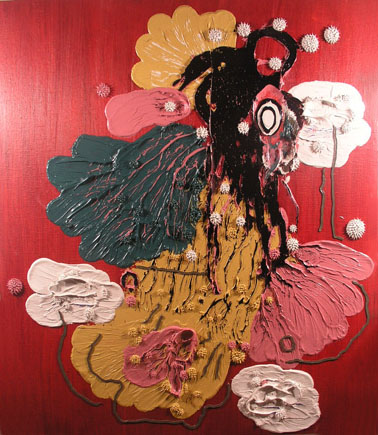
One recurring theme in the Rhizome.org blog panel tonight that is contradicted by Dennis Hollingsworth's blog: the idea that the art world always seeks to mystify and restrict access to the creator's output. Hollingsworth shows with Nicole Klagsbrun in New York and his work gets out there, as in, it's collected. He's a terrific painter and I thoroughly enjoyed the last show I saw at Klagsbrun. Complex stuff in the poMo ab-ex tradition, more seductive and paint-loving than, say, Jonathan Lasker (who I also like). Yet here Hollingsworth is on the web, letting you in on his studio process, both the physical making of paintings and his thinking about them. The above image is my slight cropping of a studio snapshot. More images are found in his post. He's a natural, talkative blogger and his step-by-steps are a gift to fans. Some artists protect their processes like trade secrets--Hollingsworth's openness shows his confidence that only he can make these paintings, and that online discussion only adds to their value, in the pure as well as commodity sense.
